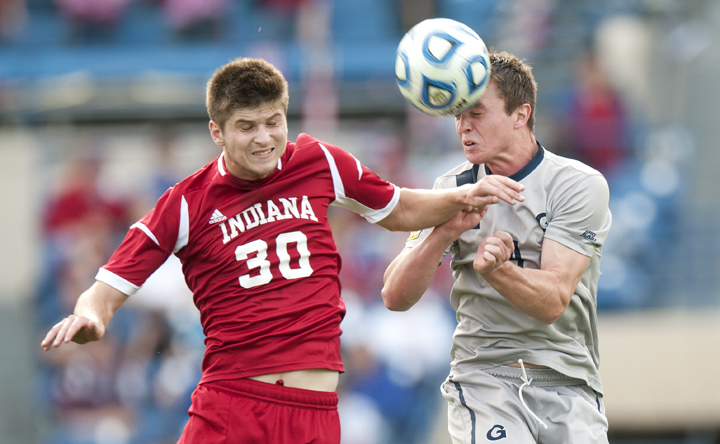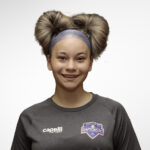LeBolt: Five things parents aren’t doing to protect their kids from concussions
 We are aware of the concussion risks. We’re getting educated about the symptoms. We’re badgering our clubs to establish concussion policies, and we are letting the referee know just how we feel about that dangerous play out there.
We are aware of the concussion risks. We’re getting educated about the symptoms. We’re badgering our clubs to establish concussion policies, and we are letting the referee know just how we feel about that dangerous play out there.
But there are five things parents aren’t doing to strengthen kids against concussions.
+READ: Overuse is Insanity: Five simple changes to keep it healthy
We need to:
1. Show them how to do basic calisthenics for upper body and core strengthening
I am amazed at how many youth soccer players can’t do a single perfect push-up: toes on the ground, back flat, nose to the ground. Or hold a perfect front plank position for 60 seconds? Side plank, same thing. Lift one arm and hold? Forget it! These are simple warmups, yet kids can’t do them, hold them, or repeat them 10 times. A strong core and upper body is what kids need to protect themselves in the air.
Calisthenics basics: push ups, sit ups, planks, burpees, crab walk.
2. Teach them to jump straight up and land lightly
 Kids can’t jump. They don’t get any height. They don’t use their arms. They have a poor sense of their body in the air. They land off balance. Hop off one foot and everything really falls apart. Helping kids lift off the ground and land under control is a skill that transfers across most sports, but they’re not learning to know their bodies this way. Controlling a vertical leap with preparation for the landing protects not only heads, but also knees and ankles.
Kids can’t jump. They don’t get any height. They don’t use their arms. They have a poor sense of their body in the air. They land off balance. Hop off one foot and everything really falls apart. Helping kids lift off the ground and land under control is a skill that transfers across most sports, but they’re not learning to know their bodies this way. Controlling a vertical leap with preparation for the landing protects not only heads, but also knees and ankles.
Plyometric basics: Touch the tape on the door frame 20 times and land without a sound.
3. Say no to mobile screens to defeat “text neck” and expand dynamic vision
Kids are constantly buried in their screens. They lose awareness and peripheral vision skills and their shoulders, neck and back muscles (not to mention their cervical spine) are crunched beyond recognition. Text neck is a real and present danger, and not just because they’re oblivious to the car that’s about to hit them as they cross the street. Dynamic vision and a swiveling head decrease the chance of being blindsided by a player or ball, which is often the culprit in concussion.
Vision basics: Put down the phone and play “I-spy” on the way to practice or the game. (Bonus: Actual family interaction!)
4. Monitor their “hit count” and stop cheering for aggressive play
 Unfortunately, soccer has been moving from a “contact” sport to a collision sport. I don’t like to see “punishing hits” and crumpling bodies in any kind of football, but there can be no place for expressions like “great hit” and “way to take a hit” in our soccer lexicon. We are not meant to collide, we are meant to maneuver.
Unfortunately, soccer has been moving from a “contact” sport to a collision sport. I don’t like to see “punishing hits” and crumpling bodies in any kind of football, but there can be no place for expressions like “great hit” and “way to take a hit” in our soccer lexicon. We are not meant to collide, we are meant to maneuver.
Kids who are overly aggressive (and coaches who encourage this) need to be advised, monitored and if necessary, removed from play. Keep a count of how many times a kid gets knocked, hits the ground, collides with a player or a goal post. The brain is shaken on all those plays.
Hit count basics: Once they reach an established number, they’re done for the day.
5. Establish a family rule to spend at least 15 quiet minutes per day
Kid’s minds, let alone their bodies, don’t rest. They’re constantly on the go and often multi-tasking on the way somewhere. Quiet time and meditation build focus, expand creativity and are healthy for the brain. Kid’s brains are changing every day. They are laying down new neural pathways and paring away others. Clear-minded kids are less mentally fatigued and handle social and emotional challenges better.
Quiet basics: 15 minutes on the clock, no excuses.
Billions in research is being spent to develop new devices (helmets, monitors, sensors, etc) that will measure impact and brain accelerations, so we’ll “know” if a player is close to or has sustained a concussion. No device is going to tell you for sure if your kid is on the verge of a concussion. Every brain, every knock, and every body is different.
+READ: Taking Action Against Concussions: Eight things you can do with your team right now
Some folks are arguing for banning heading below a certain age. I’m not sure that’s gonna help. I think we should teach them to use all parts of their body safely and under control, starting with catching and using soft-sided balls. Policies banning heading may make us feel better, but is heading really the problem? Girls basketball has a concussion problem and as far as I know they don’t head the ball at all. At least not intentionally.
If you’re concerned about concussions or others injuries with your players, contact Fit2Finish to get your free book chapter: “Beating Injuries to Keep Your Athletes in the Game.” And head to the website, where you can subscribe by email to get new blog posts delivered weekly.
SOCCERWIRE MARKETPLACE
- visitRaleigh.com Showcase Series 2025, hosted by NCFC Youth
- OFFICIAL MANCHESTER CITY SOCCER CAMPS
- Wanted Licensed Youth Soccer Coach
- Join Official Elite Summer Soccer Camps with Europe’s Top Pro Clubs!
- The St. James FC Travel Staff Coach - North (Loudoun) & South (Fairfax)
- The St. James FC Girls Academy (GA) Head Coach - 2 teams
- The St James FC Boys Travel Tryouts
- OFFICIAL BAYERN MUNICH SUMMER CAMPS U.S.
- JOIN THE ALLIANCE!
- OFFICIAL FC BARCELONA CAMPS U.S.











